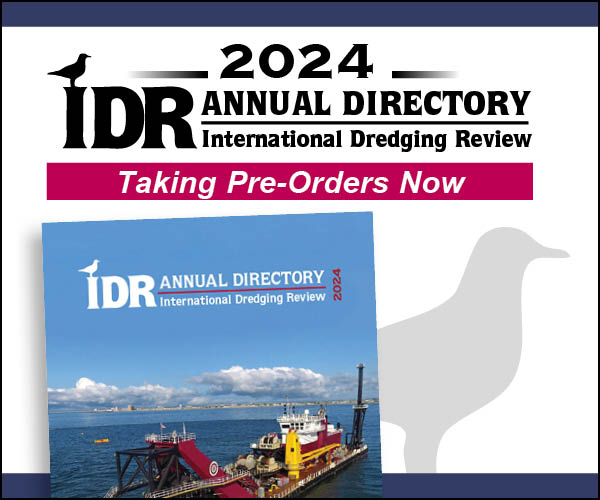WEDA Honors Innovative Practices for Environmental Excellence Awards
The Western Dredging Association (WEDA) chose its annual Environmental Excellence Awards for Navigation and Environmental Dredging led by Committee Chair Craig Vogt. The committee presents two awards in each category for the winner and runner up.
Winners were honored at the conference awards dinner Wednesday night June 24 and the projects were featured in the Environmental Commission Plenary Panel on Thursday morning.
The following highlights some of this year’s winning projects – the Environmental Dredging Winner the East Branch Grand Calumet River Remediation in East Chicago/Hammond Indiana with project team members Great Lakes Sediment Remediation LLC Environmental Restoration LLC J.F. Brennan Co. Inc. and Natural Resource Technology Co. (See IDR September/October 2014 “GLSR Approaching End of Grand CalumetnRiever Remediation Project”); the Environmental Dredging Silver Winner the Esquimalt Graving Dock Waterfront Remediation Project in Vancouver Island British Columbia with team members Anchor QEA LLC Klohn Crippen Berger Golder Associates Ltd. SLR Consulting Ltd. Salish Sea Industrial Services Tervita Corp. Fraser River Pile and Dredge and Tsunup Ventures LP and JJM Construction; the Navigation Dredging Winner the Horseshoe Bend Island Project on Atchafalaya River in Louisiana with team members U.S. Army Corps of Engineers Engineer Research & Development Center New Orleans District Weeks Marine Inc. Great Lakes Dredge and Dock Company and Mike Hooks Inc.; and the Navigation Dredging Silver Winner the Detroit Harbor Navigation Channel Dredging and Expansion Project with project team members the Town of Washington Wisconsin Washington Island Ferry Line Foth Infrastructure & Environment LLC and Roen Salvage Company.

The articulating ladder on the dredges’ cutterheads could macerate the thick vegetation in the wetlands.
INNOVATIVE EQUIPMENT AND PRACTICES
The East Branch Calumet River Project Reaches 4a and 4b remediated and restored a 1.8-mile track of the Grand Calumet River and its adjacent Seidner Marsh near East Chicago Indiana. The U.S. EPA Great Lakes National Proram Office (GLNPO) facilitated the project under the Great Lakes Legacy Act (GLLA) to address PCB PAHs and heavy metals contamination from historical industrial activities.
Great Lakes Sediment Remediation (GLSR) a joint venture between Environmental Restoration J.F. Brennan Co. and Natural Resource Technology was the prime contractor on the two-year $80 million project.
Two eight-inch hydraulic dredges removed 145000 cubic yards of contaminated sediment transporting it to a temporary dewatering site where the material was pumped into 60 geotextile tubes measuring 75 to 80 feet in circumference.

At Horseshoe Bend on the lower Atchafalaya River Louisiana the dredge California is strategically placing dredged material where the river’s energy will disperse the sediment down river to create a new island. The project won the WEDA Navigation Dredging award. (Photography by Wings of Anglers courtesy of Great Lakes Dredge and Dock).
GLSR introduced innovative amphibious equipment to mechanically excavate and transport approximately 215000 cubic yards from the adjacent wetland and Seidner Marsh. Large customized amphibious dump trucks eliminated the need for temporary roads or mat placements.
Finally 16000 tons approximately 14500 cubic yards of Aquagate + Organoclay were transported by barge and spread in the channel using J.F. Brennan’s Broadcast Spreader System.
In total approximately 360000 cubic yards of contaminated material was removed and 40 acres of wetland was remediated and restored.

Representatives from the WEDA Environmetnal Award winning projects (from l to r) Richard Webber Natural Resource Technology Matt Woltman Anchor QEA Dan Berlin Anchor QEA Ken Potrykus Foth Burton Seudel U.S. Army Corps of Engineers Engineer Research and Development Chair with Craig Voigt WEDA Environmental Committee Chair.
Other innovations on the project included the scalable temporary hydraulic dredging and dewatering system which could treat a maximum of 3500 GPM or scale down to 50 GPM.
Where hydraulic dredging is typically not used in areas with heavy debris and vegetation the project had limited land access to the river and required the GLSR team to innovatively hydraulically dredge the invasive species phragmites from the river using highly customized dredges. Both were swinging ladder style dredges with an articulating ladder. The innovative shearing apparatus on their cutterheads macerated the thick vegetation in the wetlands.
CREATING AN ISLAND
The Horseshoe Bend Island Project used strategically placed dredged sediment upriver in the lower Atchafalaya River and used the river’s own energy to disperse the sediment creating a new island in the river.
By 1999 capacity at the eight wetland development sites along the river’s banklines adjacent to the channel where dredged material was placed was nearly exhausted. To meet the placement needs of future channel maintenance dredging the Corps considered three options: converting the wetland development sites into upland disposal areas; and the openwater placement of dredged material via a longdistance pipeline into the open water in Atchafalaya Bay.
The Corps chose a third alternative which involved mounding material at mid-river open water placement sites within a 350-acre area immediately adjacent to the navigation channel and upriver of a small naturally forming island. Beginning in 2002 between 0.5 to 1.8 million cubic yards of dredged sediment from Horseshoe Bend was strategically placed every one to three years in the mid-river placement area which developed a 35-ha (about 14-acre) island mid-river.
As the project application states “The project objective was to demonstrate how dredged material can be used beneficially to nourish a naturally forming river island. Biology ecology and hydrodynamics were examined to catalog the island’s maturation for determining the effectiveness of this individual project in terms of restoring creating enhancing and protecting the coastal Louisiana landscape.”
Through a multi-faceted ecological assessment the project determined that the strategic placement of dredged material was comparable or exceeded other methods including natural formed riverine islands and traditionally created dredged material supported islands.



